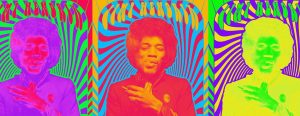Overview
Rock and Psychedelia
The rock genre originated in the United States in the 1950s and was influenced by a range of genres from folk, to country, to blues. The genre is defined by trope such as amplified and electric instrumentation, strong backbeats, and improvisation. Iconic rock bands and artists include Jimi Hendrix, The Rolling Stones, Led Zeppelin, and many more. In the late 1960s, rock was heavily influenced by psychedelia. Psychedelia is an experience achieved by the use of psychedelic drugs. While psychedelic rock was at its peak from 1966 to 1969, rock artists and fans were highly influenced by “hallucinogens, or so-called “mind expanding” drugs such as marijuana and LSD (lysergic acid diethylamide; “acid”), and that reflected drug-included states through the use of feedback, electronics, and intense volume[1].” The guitar effects pedal played a large role in the ability to create distorted, psychedelic sounding music during this time. The pedal, paired with improvisation, instrumental virtuosity, and other rock themes, produced futuristic and manipulated sounds that had the ability to take listeners to a new place with or without drugs. Jimi Hendrix used the wah-wah pedal to expand and redefine the limits of the electric guitar in rock music.
Who was Jimi Hendrix?
James Marshall Hendrix was born in 1942 in Seattle. As a child, “Young Jimmy” was interested in the music of the time, but especially by the blues music of artists such as B.B. King, Muddy Waters, and Robert Johnson[2]. After enlisting in the US Army, Hendrix worked as a session guitarist under the name Jimmy James. Eventually in 1966, Hendrix moved to London and The Jimi Hendrix Experience was born [3]. His first full-length album featuring the psychedelic rock classics Purple Haze was hugely successful in the UK. Once the phenomenon of psychedelic rock grew in popularity in the US, The Jimi Hendrix Experience seemed to become an overnight sensation. Throughout his career, his use of the guitar effects pedal was the technological tool that brought his music to life. With the release of Electric Ladyland in 1968, Hendrix’s experimentation with the wah-wah pedal and revolutionary playing techniques resulted in songs, such as “Voodoo Chile” and “All Along The Watchtower“, with strong narratives and alluring musical depth. In addition to his studio albums, Hendrix’s performance of “The Star Spangled Banner” at Woodstock in 1969 is a testament to how effectively he could convey powerful emotions and messages through the use of guitar effects pedals[4]. Hendrix died tragically in 1970. Though his musical career lasted only four years, his legacy continues to live on.
Essentially, in the late 1960s, rock music was largely influenced by the phenomenon of psychedelia, as well as sound manipulation technology like the guitar effects pedal. During this time, Jimi Hendrix revolutionized the role of the electric guitar in rock by tactfully fusing the tropes of rock music with his blues-inspired techniques and the abilities of distortion technologies such as the wah-wah pedal.
———————————————————————————————————————————————————————————
Footnotes:
- O’Brien, Lucy M. “Psychedelic Rock.” Encyclopedia Britannica. October 01, 2015. Accessed April 04, 2018. https://www.britannica.com/art/psychedelic-rock.
- “Jimi Hendrix Biography.” The Official Jimi Hendrix Site, Sony Music Entertainment, jimihendrix.com/biography/.
- Ibid.
- Sheila Whiteley. “1, 2, 3, What are we Fighting 4? Music, meaning and ‘The Star Spangled Banner’”. In Remembering Woodstock. Edited by Andy Bennett. Burlington, Ashgate, 2004, p 24.

